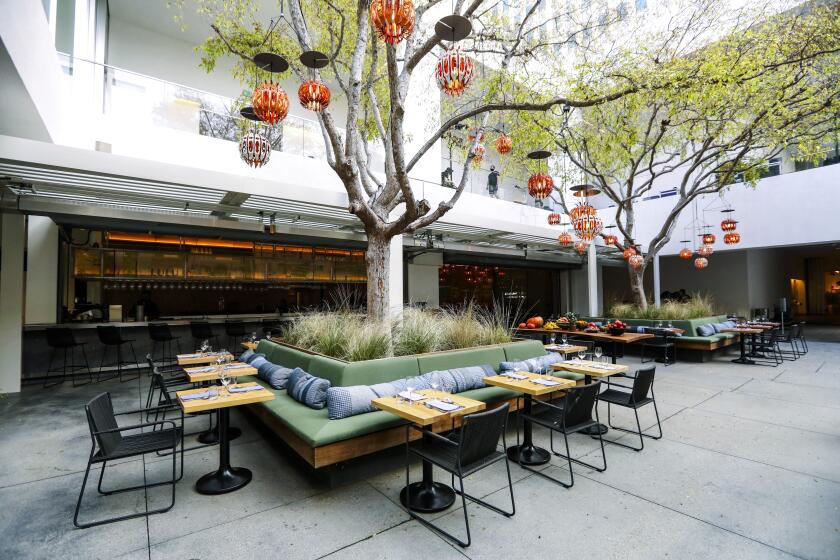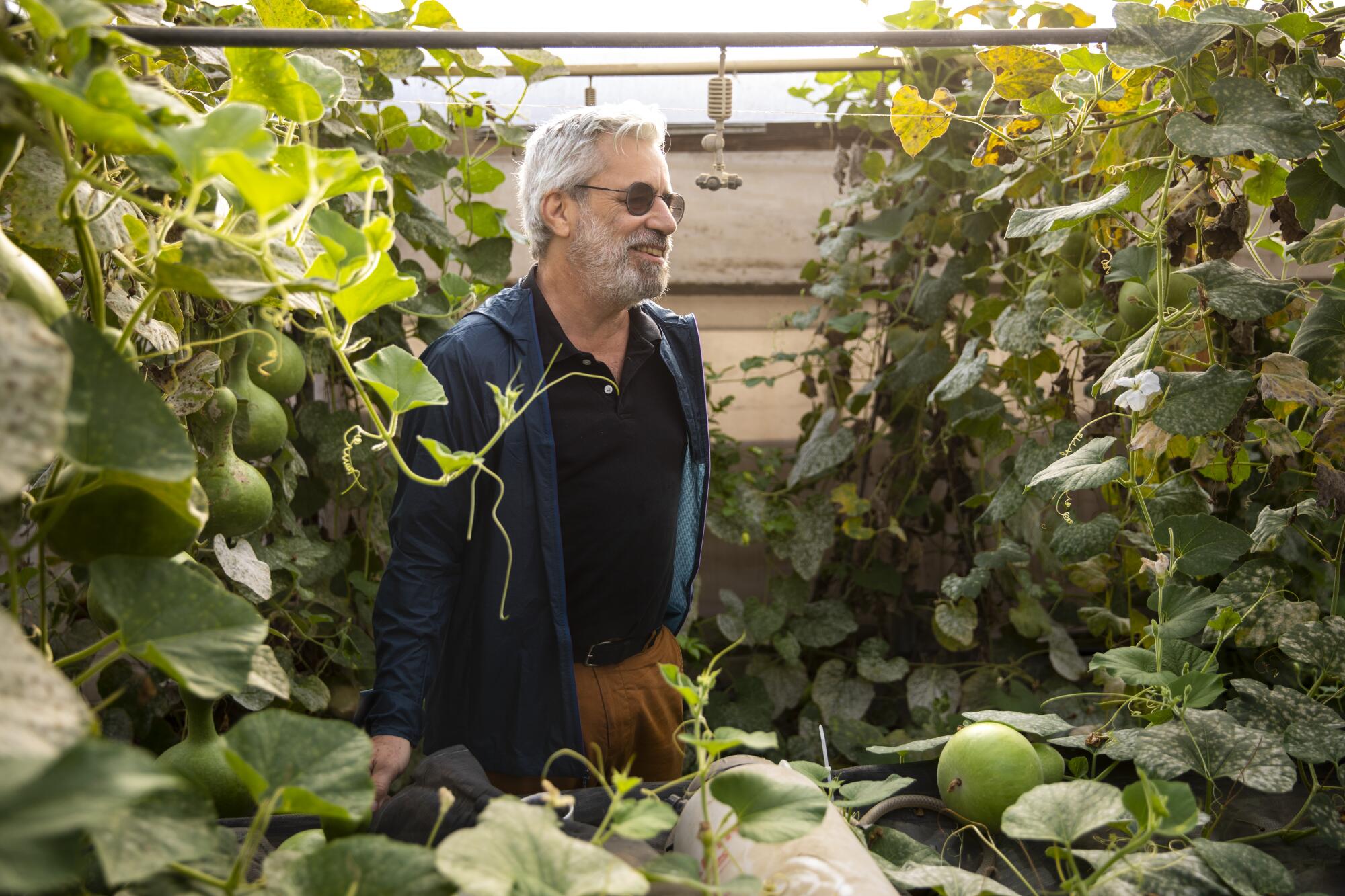
- Share via
David Tanis — one of the storied chefs in the history of Alice Waters’ Chez Panisse who, more than any other, helped define that restaurant’s cooking style — has a giant reputation. In reality, he’s of short stature, incredibly reserved, with a humility that is always a surprise when you compare him to chefs of his age with far fewer accolades.
In 1981, he started at Chez Panisse baking bread, then, a year later, became the chef of the restaurant’s upstairs cafe. In 1991, he moved to Santa Fe, N.M., to be the head chef at Cafe Escalera, which he ran for seven years before returning to California in 1998 to share head chef duties in the main downstairs restaurant with Jean-Pierre Moullé. In 2001, Tanis moved to Paris, and in 2005, he began the most enviable job for a cook: working and living for six months in Paris and working the other half of the year at Chez Panisse (Moullé had the same arrangement, although he opted for Bordeaux during his six months in France.)
In 2011, Tanis retired from Chez Panisse and moved to New York, where he began writing a weekly cooking column for the New York Times called “City Kitchen,” which ran until 2019. Now, he writes a monthly seasonal-menu column for the newspaper and has under his belt four cookbooks, the most recent being 2017’s “David Tanis Market Cooking.”
But as experienced a chef as he is, Tanis is still eager to learn. A student-like excitement comes through in how he talks with farmers market vendors, or when he asks questions about how other people cook a dish similar to one he’s cooked dozens of times. It’s in his nature to create a constant student-teacher dynamic in the way he cooks, by himself and with others. And it’s a rapport he hopes comes through with diners as he starts another chapter of his life at Lulu, his and Waters’ new restaurant at the Hammer Museum in Westwood — Waters’ first new restaurant since Chez Panisse opened in 1971.
“Chez Panisse proved there are other ways — more human ways, collaborative ways — to run a restaurant,” Tanis says. “There should always be some degree of learning going on in a restaurant. And so coming into Lulu, I don’t have a system in mind. I have a few notions of what I want the food to be and the experience of working in other places to pull from, but I approach this as an experiment in how to run a restaurant.”
Lulu is named after Waters’ and his mentor, Lucie “Lulu” Peyraud, an influential figure among many chefs and writers, such as Richard Olney, with whom she wrote a cookbook, “Lulu’s Provençal Table,” in 1994. Peyraud entertained and cooked at Domaine Tempier, her family’s wine estate outside of Toulon, in Provence, until she died in 2020 at the age of 102.
A visit to a farmers market and then The Times’ test kitchen to see what David Tanis creates in L.A.
To open Lulu, Tanis moved to Los Angeles. He’s been here since June, after living for decades in Berkeley, Santa Fe, New York City, upstate New York and Paris. When we meet up, I’m curious about how L.A. will leave its imprint on his legendary cooking style.
So, we get together and do the only thing we can to find out: Go shopping and get cooking.
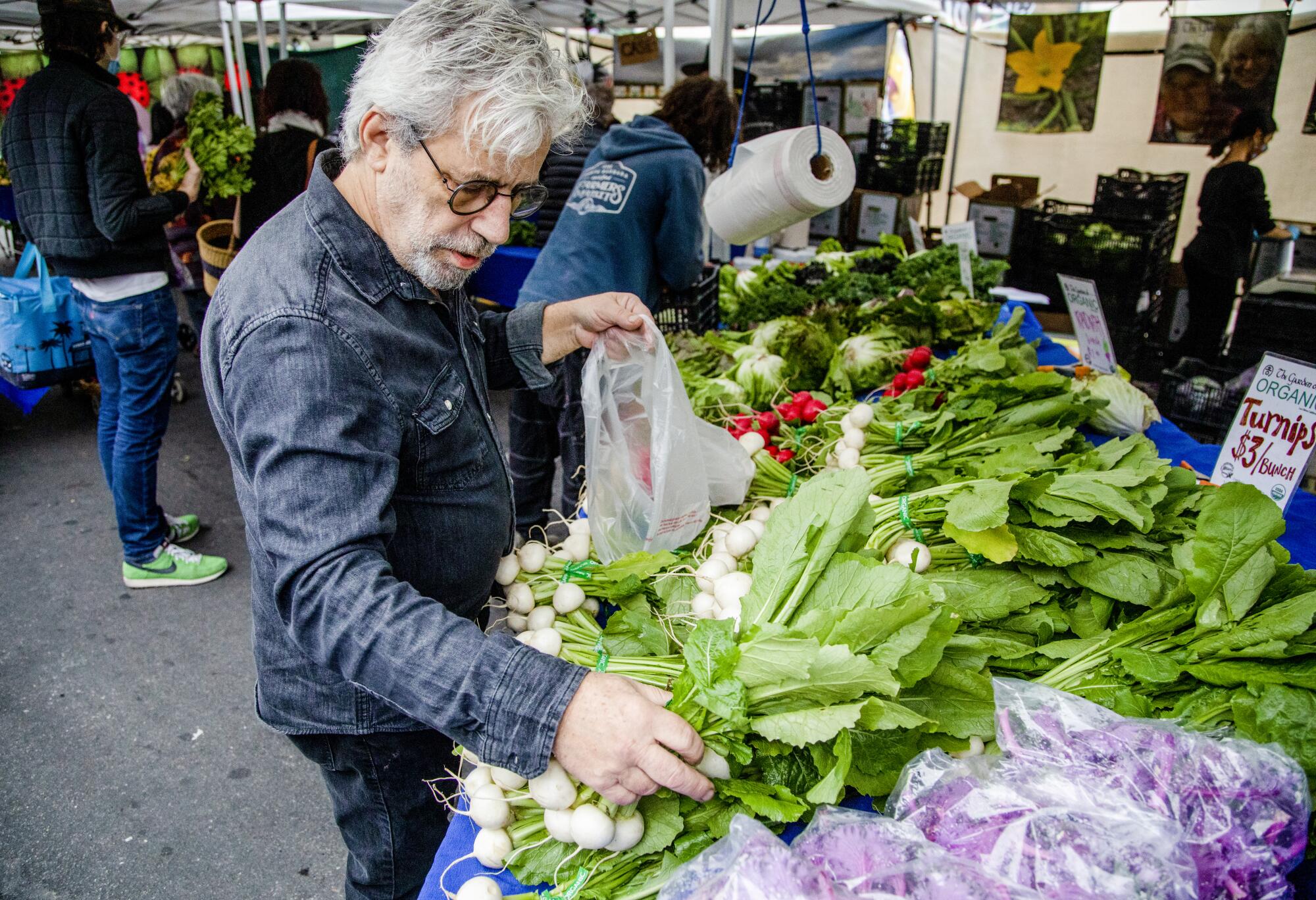
Tanis and I make a plan to meet at the Hollywood Farmers Market on Halloween morning at 8 a.m. As I drive past the western entrance to the market at 7:58 a.m., however, I see Tanis has beaten me there and is already perusing the stalls. When I finally catch up with him, he greets me with a cup of coffee and says, “I’ve already been here for a while checking things out,” followed by a playful grin.
It’s this quality in Tanis that makes him so approachable and a joy in conversation. Whereas other chefs might be loud and showy, ready with a media-trained quip about their favorite dish or a tip on how to dice onions, Tanis is quiet, studied and reserved. He’s earnest but always quick with a joke at the end of each statement to remind you to appreciate the beauty of food but don’t take it too seriously, yeah?
Lulu at the Hammer Museum is a collaboration between chefs Alice Waters and David Tanis.
As we walk up one strip of the market, Tanis’ eyes dart side to side with excitement. I point out the esoteric tropical fruits at one stand and the red walnuts at another, but a basket of black mushrooms grabs his attention first. As we walk up to the tent, Tanis asks the vendor what they are.
“Fresh wood ear mushrooms — we cultivate them ourselves,” the vendor says. “Really?” says Tanis. “I thought they only grew wild!” He buys several pounds with glee, grabbing them by the bulging fistful like a kid trying to grab candy from a Halloween bucket.
Later, we arrive at Weiser Family Farms’ stand, where one of the owners, Alex Weiser, greets Tanis with a familiar “Hey, I know this guy!” He hands us each a chunk of fresh radish that he slices off with a shiv. Tanis takes a bite and, with no change in his expression, says, “Mmm, sweet.”
He raises his eyebrows to signal he’s excited. We buy half a dozen radishes.

At other stands, we buy young turnips (“These are really sweet, so I’ll probably steam them and blanket their leaves over the top at the last minute”), sprouting cauliflower (“It’s so nice to find this; so much sweeter than regular cauliflower”) and a bag of mixed fresh chiles, a bounty he intends to use to add fresh heat to that sprouting cauliflower.
Tanis shops at the market the way he cooks in the kitchen: always with an eye toward color and capturing the beauty of the raw ingredient, whether in his shopping bag or on the plate. I point out things I find interesting and make some suggestions. To some he says yes, others no.
“I’m concerned about the way food looks,” he says. “Half of what attracts me about farmers markets is to see everyone with their wares all lined up beautifully. Going to the market, seeing what’s great and letting that influence the food I make in my restaurant — that’s always my M.O.”
It’s an understatement to say Tanis is a cooking teacher, perhaps the best. No matter the time he ran restaurants, Tanis is, above all, a practitioner of the art of home cooking. It’s the mode in which he thrives. “I’m not a ‘chef-y’ chef,” Tanis says. “My approach to cooking is not stylized or rigid. In a lot of cuisines, the home cooking is what stands out for me. I enjoy the act of cooking at home and want the food in a restaurant to taste just as good.”
His style is on full display when you watch him make, of all things, a salad. Back in the L.A. Times’ test kitchen, Tanis ably wields a paring knife to skin a Fuyu persimmon, releasing the skin from the fruit in one continuous loop. He slices the persimmon into thick wedges, then breaks open a pomegranate and flecks the arils over the fruit. A drizzle of olive oil rains down, along with some salt and pepper.
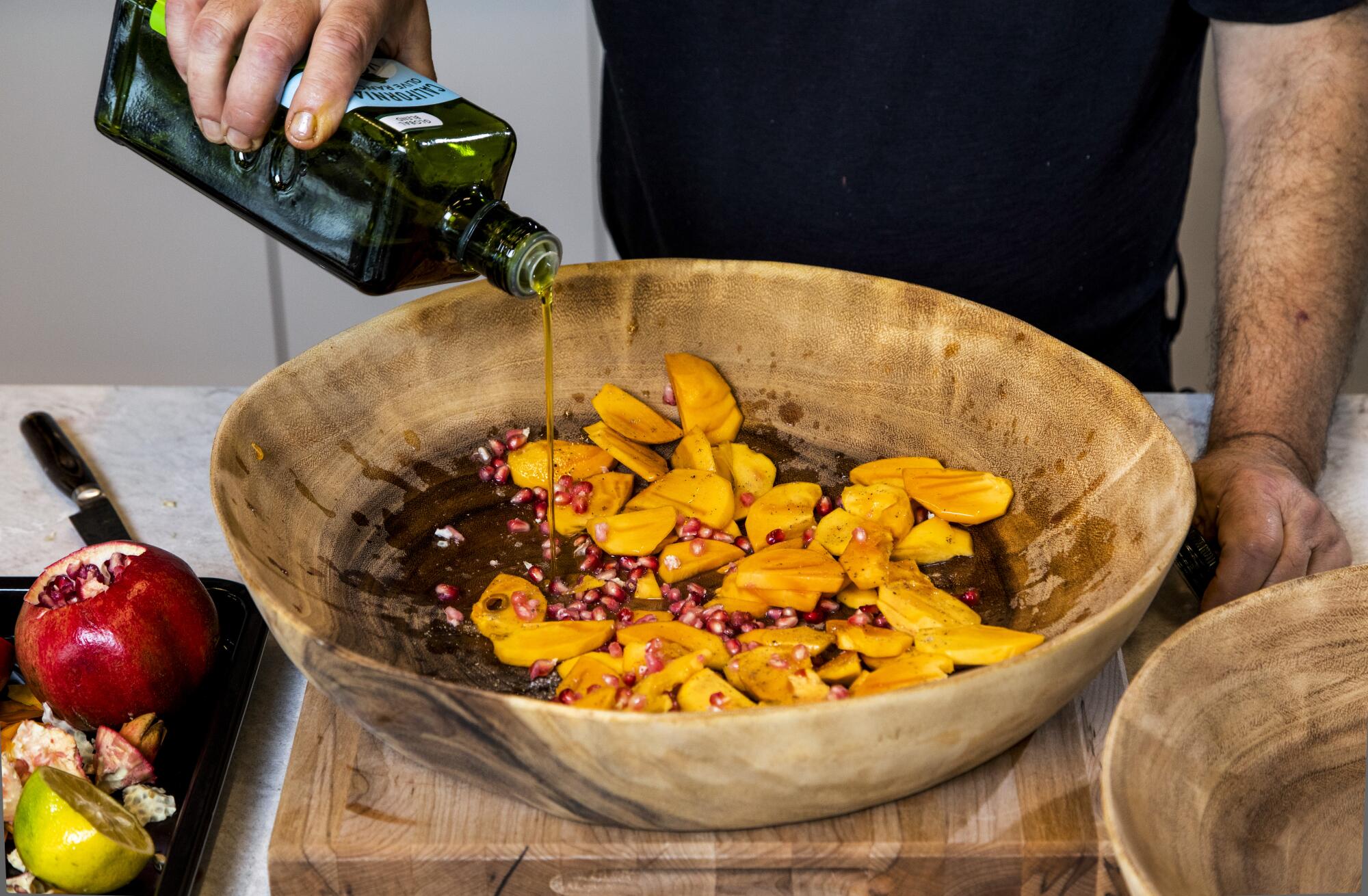
Then Tanis’ fingers take over. He opens his palm with rigid, slightly bent digits, like a wizard about to cast a spell, and uses his fingers like the wires of a whisk to mix the seasonings with the fruit, drawing out their juices. He tastes a wedge of persimmon, mutters a satisfied “mmm,” then reaches for more salt.
“This can be a salad in and of itself with a few mint leaves or chopped herbs, but it would also taste good with slivered fennel,” Tanis says. “I like the combination of sweet and bitter, so I’m going to take these bitter Treviso leaves — almost so beautiful you don’t want to break them up — and then the Castelfranco [lettuce]. I’m going for the tender inner leaves, which happen to also be the most speckle-ty ones,” he says with a wide grin. “This is one of those salads where all the good stuff wants to fall to the bottom of the bowl.”
Once done, I feel like I’ve never seen a salad come together so beautifully and with such attention to detail. This is the magic of Tanis’ cooking: He turns beautiful ingredients into, somehow, more extraordinary dishes, but without complex seasonings or tricks, proving that you don’t need to cut corners on quality to make something “quick.”
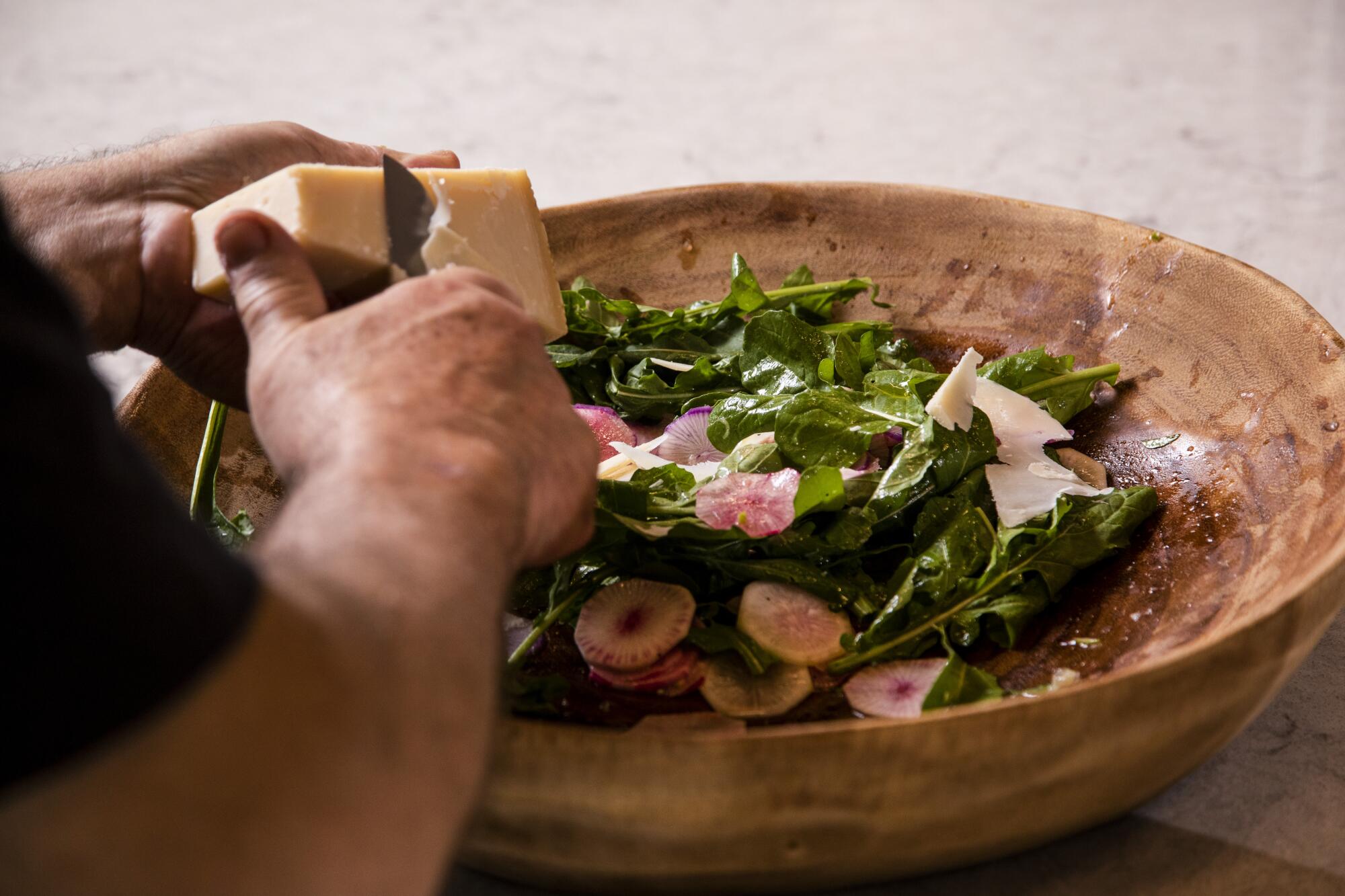
Next, he moves on to another salad of radishes with arugula, lime and parmesan. “You don’t have to peel [the radishes],” he says. “But I like them peeled because the skins are on the tough side.” These small snippets of cooking wisdom are what separate the good from the great, and Tanis is full of them.
Fat king oyster mushrooms are trimmed, then painted with olive oil before being sent screaming into a hot skillet to brown and hiss off their moisture. “If I had a grill, I’d grill them, but a skillet works just fine,” he says. “The point is to get them really browned to impart as much flavor.” Right before the king oysters finish cooking, he showers them with the wood ear mushrooms and some minced garlic and cilantro, to just warm the aromatics through and take off their raw edge.
After he sautées the sprouting cauliflower in the same manner and finishes it with minced garlic and cilantro too, I ask why he adds the garlic in the end. “You don’t want it to burn,” he says with a deadpan. I laugh because, well, he’s right, but so much recipe rhetoric is about cooking garlic first, then adding vegetables to lace them with its flavor. But Tanis knows that a couple cloves of minced garlic, tossed in for the final 30 seconds of a sauté, will yield just as fragrant and flavorful results without the worry of it burning or turning bitter.

Our attention stays on garlic as he works on a dish of slow-cooked tender-stem broccoli, the stalks cut into large chunks and the leaves left intact. He dots a few whole garlic cloves, still in their peels, among the greens with a splash of water and begins to cook it under the cover of the pot. After several minutes, he tests the broccoli to see if it’s done. “It should mash pretty easily when I prod it with the tip of my spoon,” he says. This is no al dente situation; he wants the broccoli soft and sweet, to balance the chile flakes that dot the dish at the end. Once he plates the broccoli, the garlic cloves come with it onto the plate. “I don’t mind leaving them in,” Tanis says. “It’s nice for someone to get a mushy garlic clove to play with.”
When he moves on to a final dish of young turnips steamed with their greens, his brilliance really comes into focus. He judges the size of each irregular turnip and artfully cuts them into uniform wedges. All the turnips go into the pot but he stops shy of adding all the stems, holding a little back after a first generous covering, eyeing the proportions to ensure they stay how he wants them.
He splashes in some water and simmers the turnips and stems until just tender. He doesn’t judge their doneness with a tip of his knife; instead, he jams his finger straight into the simmering vegetables to pluck a wedge out. “That’s hot!” he says calmly, flashing another grin. The confidence in Tanis’ hands makes them all the more thrilling to watch.
The turnips are ready, so he now adds their greens, scattered strategically over the top, for a final few minutes of wilting. A sprinkling of marash chile flakes rains down, then the turnips are on the plate. He glides his fingers here and there, poking the leaves until they arrange themselves into an ideal pattern. Salt, olive oil; purity, amplified.
I ask Tanis how he finds inspiration for such beautifully unfussy home cooking. “Even though I have restaurant experience, I’ve also written hundreds and hundreds of recipes,” he says. “So if I need to pull something out of my hat, that’s the library I’ll pull from. And when I was in college, I studied liberal arts — visual arts, poetry and dance, all that — so there is a part of cooking that is an artistic expression for me; art printed in 3D. And it smells, so it’s multimedia.”
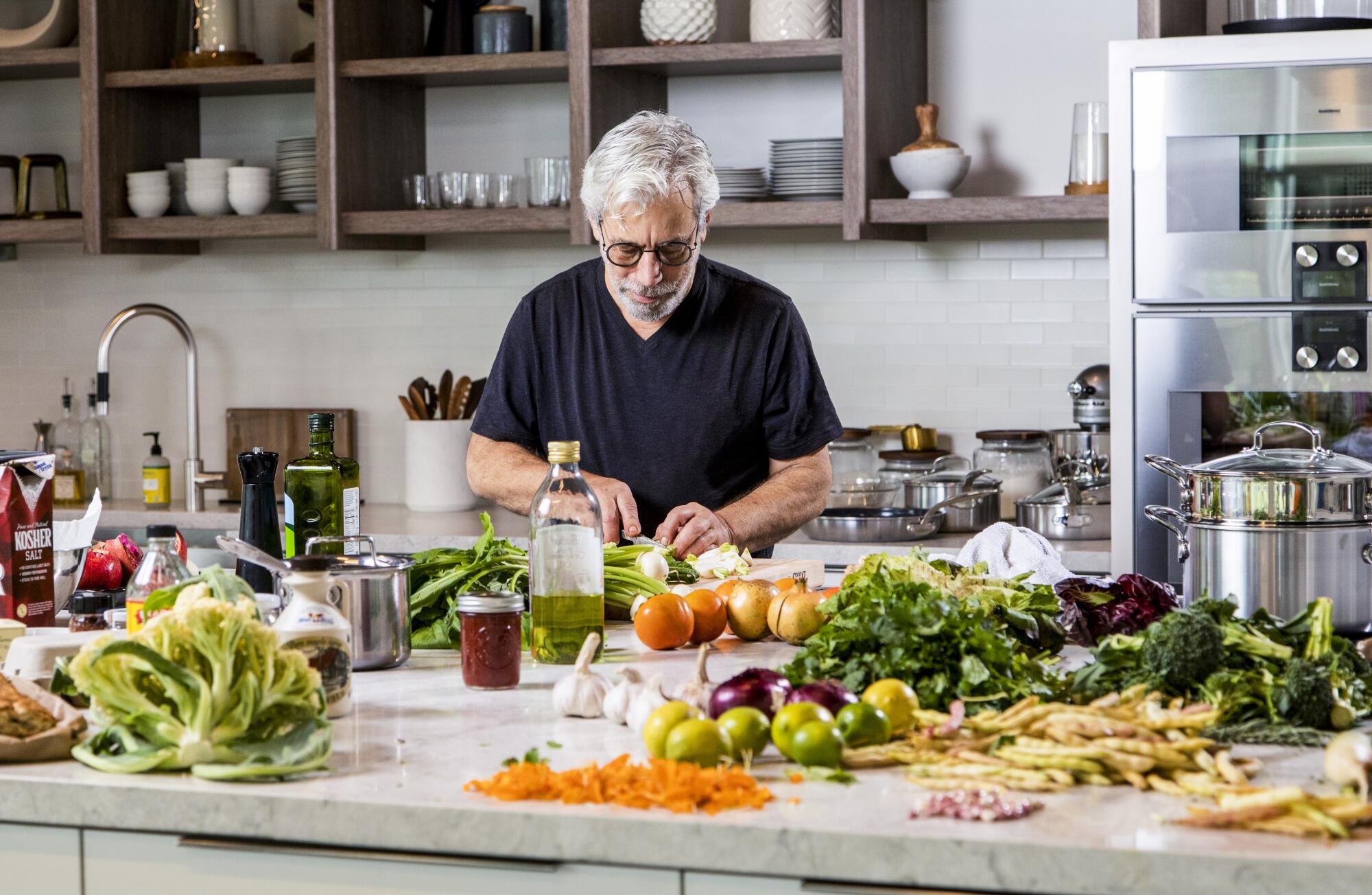
As we eat the food he’s cooked, there’s a language that jumps out immediately. Chiles, both fresh and dried, are wielded with florality in mind, not heat. Lime juice adds bitter acidity where most people would reach for the sharpness of lemon. Minced garlic is sprinkled at the end, its funk mellowed for sweetness rather than toasted for umami like when added at the beginning of cooking. And all his vegetables are cooked to a soft toothsomeness that you rarely encounter these days in our tender-crisp culture. Restaurant precision applied to home cooking simplicity.
It can feel, watching Tanis cook, like he’s on another plane entirely in the practice. The way he thinks about flavors, combining ingredients and creating a dish is unparalleled in its understated assurance. He has an innate understanding of beauty in restraint — perhaps harkening back to his art-school background — that probably comes across as ordinary to him but seems inspired and brilliant to the rest of us.
“When I cook, I’m not trying to reinvent the wheel,” he says, “but rather, work with a different kind of wheel.”
More to Read
Eat your way across L.A.
Get our weekly Tasting Notes newsletter for reviews, news and more.
You may occasionally receive promotional content from the Los Angeles Times.

